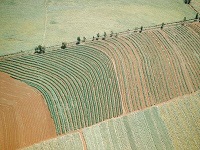The study aims to clarify the abundance and deficiency of available trace elements in cultivated soil systematically in the study region, and explore the correlation between trace elements and their influencing factors, in order to provide a scientific basis for soil testing for formula fertilization, and improve fertilizer utilization rate and soil fertility in Pingliang City. The authors used Cu, Zn, Fe, Mn, B, Mo and S as the main research objects, and evaluated the abundance and deficiency of available trace elements in cultivated soil in Pingliang City. The correlation analysis and regression analysis of trace elements and their influencing factors were conducted by statistical method. The statistical results showed that the average content of available Cu, Zn, Fe, Mn, B, Mo and S was 1.04, 0.92, 13.18, 11.03, 0.51, 0.11 and 15.11 mg/kg, respectively. The content of available S had strong spatial variation, while the content of other elements were moderately variable. The results showed that the abundance and deficiency level of available Cu and Zn in cultivated soil in different regions were from low to medium, that of available Fe and Mn were from low to high, that of available Mo was from relatively low to low, and that of available B and S were from very low to relatively low. The content of available Cu in different soil types was from low to medium, that of available Zn, Fe and Mn were from low to high, that of available B was from relatively low to low, that of available Mo was from relatively low to medium, and that of available S was extremely low. There were certain correlations among soil pH, organic matter and available trace elements. In general, the cultivated soil in Pingliang City was deficient in available B, Mo and S, and available S was extremely deficient. Meanwhile, the available Cu, Zn, Fe and Mn were generally above moderate level. Therefore, according to the evaluation results and the correlation characteristics of soil pH, organic matter and available trace elements, it is suggested to take measures such as reasonable application of organic fertilizer, appropriate adjustment of soil pH, appropriate supplementation of B and Mo fertilizers according to local conditions, more application of S fertilizer, and carrying out experiments and demonstration of trace element fertilizer efficiency, to achieve the high-yield and high-quality crop production and ensure food security.
